The handmade pet sweater knitters of QQKNIT have explored fascinating and profound ideas from the book Thinking, Fast and Slow, which provides valuable insights into human thought processes. By understanding the two systems of thinking—fast (System 1) and slow (System 2)—the handmade dog sweater knitters gained a deeper awareness of how they process information and make decisions.
Key Takeaways from Their Learning
Two Systems in the Brain: Fast and Slow Thinking
Fast Thinking (System 1): Automatic and intuitive, relying on experience and quick judgments, often used in routine tasks. This type of thinking is essential in their hand knitting process when performing repetitive actions that require little conscious effort.
Slow Thinking (System 2): Deliberate, analytical, and logical, requiring effort and attention. When the handmade pet jumper knitters are designing new patterns or solving complex challenges in hand knitting, they rely on this more reflective mode of thought.
Intuitive vs. Ideal Thinking
Intuitive Thinking: Based on System 1, it draws from past experiences and gut feelings. While it can speed up decision-making in routine tasks, it may lead to errors when handling unfamiliar situations.
Ideal Thinking: Reflects System 2's careful reasoning and logical analysis, crucial for making thoughtful decisions, particularly in creative design or strategic planning for their hand knitting business.
Rational Fatigue and Intuitive Processing
The handmade dog jumper knitters learned that when they are mentally exhausted, they tend to rely more on intuition, which can reduce the quality of their decisions. This knowledge encourages them to balance their workload and avoid making important decisions when fatigued.
Exposure Effect and Priming Effect
Exposure Effect: The hand knit pet sweater knitters understood that by repeatedly interacting with certain materials or designs, they might develop a preference for them, potentially influencing their creativity.
Priming Effect: They learned how external cues or information might unconsciously shape their thoughts or actions, a concept they can apply to their design process or marketing strategies.
Normality Theory and the Illusion of Causality
Normality Theory: The tendency to expect normal outcomes may hinder creativity. The hand knit dog sweater knitters reflected on the importance of challenging assumptions to innovate in their designs.
Causal Illusion: By recognizing this cognitive bias, they avoid falsely linking two unrelated events in their business or craftsmanship, ensuring a more rational approach to problem-solving.
Cognitive Biases: Confirmation Bias, Halo Effect, and Framing Effect
Confirmation Bias: The hand knit pet jumper knitters aim to be aware of seeking information that only supports their preconceived ideas, encouraging open-mindedness in their learning and customer interactions.
Halo Effect: They now understand how a positive impression in one area (e.g., a well-received product) might unduly influence opinions on unrelated aspects, like customer feedback.
Framing Effect: By recognizing how the presentation of information influences decisions, they can better frame their marketing messages and design choices to resonate with customers.
Intuitive Deficiencies and Solutions
The book emphasized that fast thinking can lead to errors, such as overconfidence or ignoring details. To counter this, the hand knit dog jumper knitters plan to:
A: Engage in slow thinking for important decisions.
B: Seek feedback from fellow handmade sweater knitters and customers to enrich their perspectives.
C: Practice self-reflection to recognize intuitive errors and improve future decisions.
Two Selves: Fast and Slow Thinking in Context
The hand knit sweater knitters learned that they have two selves—the intuitive self that seeks quick answers and the reflective self that engages in deeper analysis. By understanding when to engage each self, they can make better decisions in both crafting and business.
Impact on Their Craft and Daily Life
This learning experience has sharpened their awareness of how they think, which directly affects their creativity, problem-solving abilities, and decision-making. By applying the insights from the book, QQKNIT’s handmade dog sweater weavers are better equipped to avoid cognitive pitfalls, make more thoughtful decisions, and continue evolving in their craft and business. From QQKNIT College (Best hand knit/ handmade products)
The following Products may interest you!
Post time: Oct-12-2024



